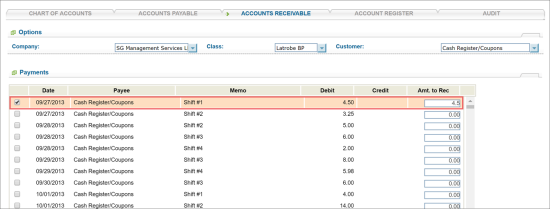Accounts Receivable represent the outstanding invoices a company has or the money the company is owed from its clients. Receivables essentially represent a line of credit extended by a company and due within a relatively short time period, ranging from a few days to a year.
Using the Accounts Receivable form, you get the following advantages:
- You can track money owed to you in an organized manner to reflect an aging accounts receivable report.
- You can view an accurate cash flow statement based on accounts receivable collections.
- You can establish your good customers that pay on time and in full.
Accessing Accounts Receivable Form
You can access the Accounts Receivable form in the following ways:
- Go to Customers > Accounts Receivable > Accounts Receivable.
- Go to Transactions > Account Register, and then click the Accounts Receivable tab.
Collecting Invoices
To collect an invoice, follow the steps:
- Open the Accounts Receivable form. For details, see Accessing Accounts Receivable Form.
- In the Options section, select the following data:
- Company
- Class
- Customer
- In the Payments section, select the debit invoice you want to collect.
You may use the customer's credits, if any, for mutual accounting. In this case, make sure you have selected both credit and debit payments.
- (Optional) In case you need to collect partial amounts, in the Amt. to Rec column, enter your value and then click any empty space to save this value.
- Go to the Payment Attributes section, and then specify the following data:
- Receive Method: Select Check, Cash, or EFT.
- Receive Account: Select an account to pick the money in.
- Receive Date: Select the receiving date.
- At the bottom of the Accounts Receivable form, click Receive & Close to complete the transaction.
Accounts Receivable Training






